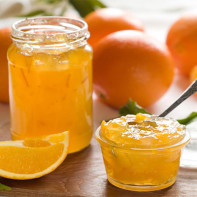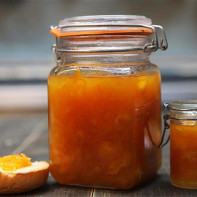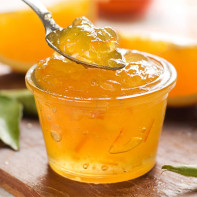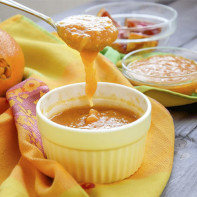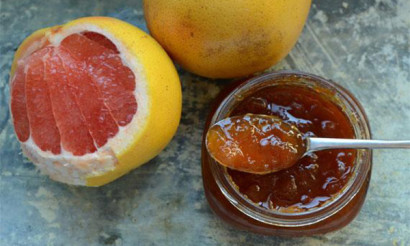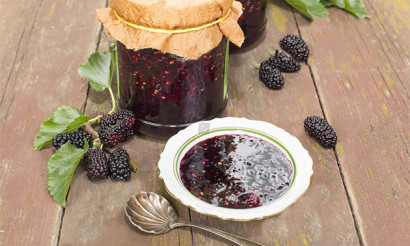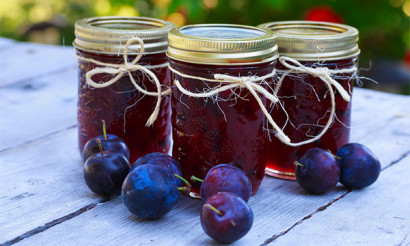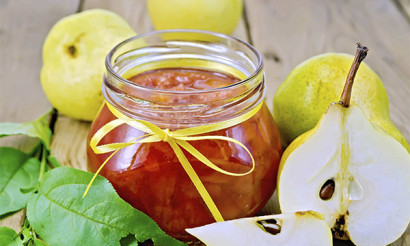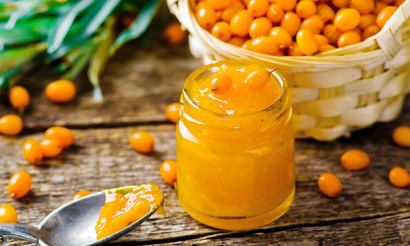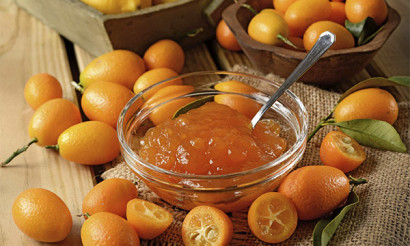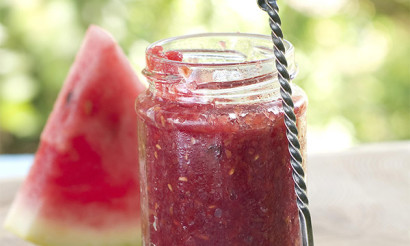Jam from oranges: 13 recipes
The smell of orange in many is associated with the New Year holidays. This is understandable, it is during the winter months that the season of citrus fruits imported from Turkey, Egypt, South Africa and Morocco falls. Abkhaz oranges ripen in December and are sold almost until spring, capturing March a little. When suddenly a few citruses have accumulated, and I don’t want to eat them anymore, it’s worth recalling and implementing some delicious jam recipes.
- A bit about orange
- Composition and calorie content
- What is useful orange jam
- For women
- For men
- For children
- How to choose oranges for jam
- How to make orange jam: recipes
- Classic
- With pumpkin
- With lemon
- With zucchini
- With apples
- With tangerines
- With gooseberries
- With dried apricots
- With persimmon
- With feijoa
- With rhubarb
- With cranberries
- In a slow cooker
- Interesting facts about oranges
A bit about orange
The culture is considered the most common among citrus fruits. The homeland is called China, from where the Portuguese sailors brought the plant to Europe. The trees were so spectacular during flowering and in the period of fruit ripening that the fashion for growing small groves of citrus quickly spread throughout the countries of the Old World. Since even very mild winters were fatal for oranges, it was necessary to build covered glass galleries, later called greenhouses from the French orange, which means "orange."

Wise eastern healers used the beneficial properties of the plant another 2.5 thousand years BC. Europeans had to discover them for themselves. First of all, they drew attention to the amazing properties of juicy pulp to quench thirst, relieve febrile states and restore strength after exhausting work. The next revelation was the benefit of orange peel, which stores a huge amount of essential oils that enhance mood and strengthen immunity.
In cosmetology, the use of orange oil and fruit zest was quickly found. They improve color, tone and refresh the skin, slow down aging and tighten the oval of the face. In its pure form, juice is not used, it is too caustic for such purposes. But masks, lotions and tonics with the addition of orange essential oil have proven themselves well.
The housewives immediately began culinary experiments, and since citrus was an exotic and rather expensive product, all parts went into business. There were recipes for pulp and crust jam, methods for making candied fruit, jam and tender confiture.
Currently, orange groves can be found on most of the Mediterranean coast. The main fruit producing countries are Brazil, China, India, Mexico, Iran, Egypt, Spain.
Outwardly, the tree is very beautiful, covered with small leathery leaves of dark green color. In winter, it does not drop leaves, as it belongs to evergreen species. Throughout the year, deciduous cover is gradually renewed, without completely exposing the branches. During flowering, the tree is covered with white flowers, grouped in 6 in one node. The fruits are juicy, covered with a porous crust, internally divided into lobes. There are varieties with a large number of seeds, but many hybrids have only 3-4 pieces inside.
The tree has a lifespan of about 150 years, while it grows to 12 m. Long-livers are known, whose age reached 400 years. With a plentiful harvest, 1 tree can produce up to 38 thousand fruits. Most varieties are remontant, on the branches at the same time are fruits of varying degrees of ripeness, so the fruiting period lasts several months.
Composition and calorie content
The juicy pulp and skin contain:
- antioxidants;
- volatile;
- vitamins C, PP, E, B;
- pectin;
- fruit sugars;
- polyunsaturated fatty acids;
- vegetable protein;
- 60 types of bioflavonoids;
- essential oils;
- iron;
- calcium;
- magnesium;
- silicon;
- phosphorus;
- potassium;
- biotin;
- organic acids.
Calorie content is very small, the indicator of 100 g of product barely crossed the bar of 45 kcal.
What is useful orange jam
The aromatic pulp of citrus contains enormous potential for maintaining the body, filling the deficiency of vitamins and mineral salts. Healers of ancient Egypt used the sun fruit in the treatment of even serious diseases.
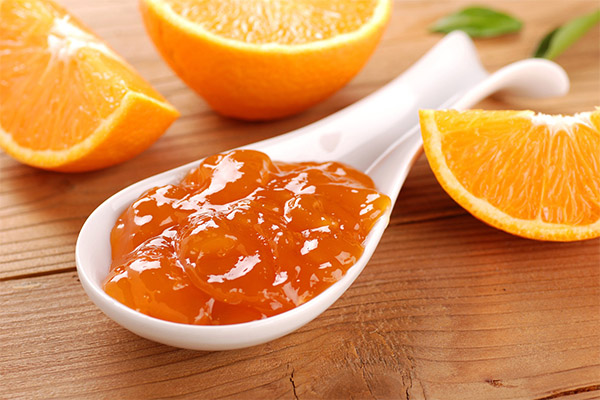
Interesting: the aroma of orange can relieve stress and stabilize the emotional background.
During heat treatment, some of the vitamins are lost, but other properties are enhanced and the level of allergenicity of the product is reduced. In addition to the prevention of vitamin deficiency and the restoration of strength after operations, overwork and colds, an orange is capable of:
- normalize digestion;
- relieve chronic fatigue syndrome;
- prevent the development of scurvy and atherosclerosis;
- stabilize blood pressure;
- increase efficiency and immunity;
- slow down age-related changes;
- cheer up.
As a prophylactic, pulp, juice and jam are recommended to be included in the menu for delayed regeneration, a constant loss of strength, during prolonged stress, increased mental and physical stress. With edema, the mild diuretic effect of the fruit is useful, and for people with cardiovascular diseases, a high concentration of potassium in the fruits becomes especially valuable.
Preserved in jam and antibacterial properties, which are indispensable during seasonal epidemics. A few slices of sunny fruit will relieve nausea and other manifestations of toxicosis, help relieve ailments during motion sickness in transport, reduce irritability and improve mood.
The high content of citric acid and citrates prevents the formation of sand and kidney stones, activates excretory processes. Vitamin C reduces the risk of developing leukemia and malignant tumors.
For women
Particular attention should be paid to the properties of citrus to relieve emotional stress, redirecting it to a positive channel. Essential oil of orange tones, dispels a gloomy mood, gives confidence, eliminates anxiety. It can stop impending depression and alleviate the symptoms of PMS. Due to the high concentration of flavonoids, these properties are preserved after heat treatment. A few spoons of jam are guaranteed to eliminate the spleen and give a boost of energy for the whole day.
Pectins and fiber stimulate the intestines, accelerate the removal of toxins, cleanse the body, prolonging youth and significantly slowing down the aging process. Speeding up metabolism allows you to increase the effectiveness of programs aimed at controlling and reducing weight.
For men
Solar citrus increases stamina, strengthens resistance to viruses and pathogenic bacteria. Pulp and juice quickly restore strength after physical exertion and intense strength training.
The anti-inflammatory effect of orange reduces the risk of developing prostatitis. Orange is known as a powerful aphrodisiac, it gently relaxes, while intoxicating with passion.
For children
Modern sweets are crammed with dyes, stabilizers, flavor enhancers. Sometimes after sweets, not only the baby’s tongue retains the color of goodies for a long time, but even the pot smells of flavorings. It is much more beneficial to give an orange. It will strengthen the immune system, replenish the vitamin reserve, normalize the work of the endocrine, cardiovascular, digestive system and simply delight with a rich taste.
Important: citrus fruits are strong allergens, so it is worth observing the measure in their use.
Restrictions for use
Fresh fruits are much healthier than jam or jam. But they have more contraindications. It is not recommended to eat oranges and drink freshly squeezed juice in case of exacerbation of gastrointestinal tract diseases, stomach ulcer, high acidity.With individual intolerance, you will have to abandon them altogether. The diagnosis of "urolithiasis" will be the reason for consulting a doctor in order to determine the ratio of harm and benefits of citrus. Adults need only 2-3 fruits per day, a child should not give more than 1 per day.
It is worth considering: orange jam has much fewer contraindications, since some of the substances during cooking are transformed into more easily digestible forms, and the acid level of the fruit is significantly reduced.
How to choose oranges for jam
Some scholars argue that a wild form of orange does not exist. There is a hypothesis that the fruit was obtained by spontaneous crossing of the pomelo and mandarin. So it is or not, it does not matter, the main thing is that breeders have bred many varieties, each of which has its own taste characteristics. There are large fruits with a thick skin, small with a very thin skin. Their ripening dates are also different. The most popular varieties that are most often found on the shelves are Gamlin, Verna, Salustiana, Navel Lat, Navelina, Valencia. There are oranges with red flesh or dark skin color. They are a more exotic product and are very rare on sale.
It is not necessary to be an expert on varietal differences and to be interested in the name each time. It is enough to know a few signs of quality sweet fruits.
- By weight, you can determine the level of juiciness. The fruit must be weighty, firm. Then in most cases it will be sweet, ripened.
- Size is not a criterion of good taste. Most often, a fairly average level of juiciness and sour flesh are hidden behind the thick peel of a voluminous fruit. In this case, you will have to overpay for the crust, which even candied fruit is not recommended.
- The appearance of the fruit says a lot. Uniform saturated color is found only in sweet ripe fruits. They should not have dents, soft patches, dark spots.
- The smell immediately gives out the quality of the fruit. As soon as a trace of mold, musty or wine spirit is felt in it, you will have to refuse the purchase. Most likely, storage and transportation conditions were violated or the fruits are already starting to deteriorate from time to time.
- The dense structure of the crust indicates ripeness and a high level of juiciness, but only in thin-skinned species. There is nothing to be felt through the porous peel and again an additional expense will be obtained for what does not go into food.
It should give preference to medium-sized fruits with a thin skin. It is they who most often turn out to be the juiciest and sweetest, which will reduce sugar consumption and get a delicious treat.
How to make orange jam: recipes
Jam from oranges is cooked with and without peel, with neat slices that preserve the structure, or in the form of a homogeneous mass passed through a meat grinder. The methods of adding various ingredients that give the classic version new taste shades are popular. The choice is great and depends on the personal preferences of the hostess.

Classic
The simplest recipe that does not require special culinary skills. It will take 1 kg of granulated sugar, peeled orange slices and a little patience. Citrus peeled and white veins, cut into cubes or leave slices. But in this case, they are pricked in 2-3 places with a wooden toothpick. They are covered with sugar on top. To get the juice, they wait half an hour, then add a little crushed crusts to enhance the aroma and begin to boil the mass. It will take 2 hours for readiness. At the discretion of the hostess, time is divided into several approaches, followed by cooling of the mixture or immediately maintained until the syrup thickens.
With pumpkin
The taste of citrus fruits is very saturated, therefore, in the name of economy and for variety, the orange is combined with other products. Pumpkin base softens the acid, gives softness and tenderness to jam. It is appreciated as an independent dessert and filling for pies.
Ingredients:
- pumpkin - 1 kg;
- sugar - 1 kg;
- orange - 2 pieces;
- water - 500 ml.
Preference is given to medium-sized citruses with a thin skin. They are sweeter and more aromatic.
Pumpkin is cut into cubes, oranges are driven through a meat grinder along with the skin. The bones are previously removed, otherwise the finished product will be bitter. First, syrup is boiled, pumpkin is poured with boiling liquid, citrus puree is immediately added to it. Cook for 20 minutes. This time is enough for the mass to become thick and very fragrant. For long-term storage, it is distributed in sterilized jars with sealed lids.
With lemon
The combination of two citruses gives an indescribable sweet and sour delicate flavor. This jam will be a wonderful sweet gift for friends or work colleagues. It is almost transparent, a gentle sunny color. The delicacy splendidly raises the mood, strengthens the resistance to viruses during the period of mass colds.
In order not to bother separately with each slice, it is more convenient to immediately drive the main ingredients through a meat grinder. For a small test portion, take 4 oranges, 2 lemons per 500 g of granulated sugar and 1/3 cup of water. If the recipe is to your liking, then the amount is doubled or tripled.
To fully open the bouquet of smells, the whole fruit is first scalded with boiling water and only then cut into 4 or 8 parts to remove seeds. The peel does not need to be removed, it will also go to jam.
Then the crushed mass is filled with sugar, add water and cook in 1 approach for at least 25 minutes. Jam insist 4-5 hours. Then it is brought to a boil and laid out in banks.
As a festive option, not crushed crust is put in jam, but planed with thin curls. To enhance the anti-inflammatory and antibacterial effects, 5 g of ginger root is added 5 minutes before readiness.
With zucchini
This vegetable has an interesting property to change the taste in accordance with other ingredients. In combination with cherry plum and plum, a pineapple flavor is obtained, and when combined with an orange, it takes a bitter note from the peel, giving a delicate fruity taste. Zucchini will need 2 times more than citrus. Sugar is taken at the rate of 1: 1 to the fruit and vegetable mass, crushed in a blender. Cooking time - 1 hour.
Important: to avoid burning take a pan with a thick bottom.
With apples
This is a great combination of tastes and aromas. The most delicate apple slices become transparent and absorb the entire flavor bouquet. For cooking you will need:
- apples - 1 kg;
- sugar - 1 kg;
- water - 250 ml;
- oranges - 2 pieces;
- ground cinnamon - on the tip of a knife.
Oranges are cut together with the peel into 4 parts, the bones are taken out of the pulp. Citruses are put in a pan and boiled for 5 minutes. Then they are removed and cut each quarter into thin strips across the cross section. Almost triangular slices are obtained. Apples are peeled, cored, pulp chopped into cubes.
Sugar is added to the liquid, syrup is prepared. After complete dissolution of the sugar crystals, it is poured into fruit slices and brought over low heat until cooked. It is checked for a drop of syrup on a plate. 2 minutes before the end of cooking, add ground cinnamon. Half of cinnamon sticks will give a richer flavor to jam.
With tangerines
This delicacy is cooked only from peeled fruits, sorted into slices. They are pricked with a toothpick, put in a container for cooking and covered with sugar at the rate of 1 kg for an equal amount of citruses. In total, 3 kg of sweet mass should be obtained.Before cooking, add 10 g of fresh ginger. You can use dried, but then reduce the amount by half. The first time the mixture is boiled over low heat for 60 minutes. Then let the jam cool and repeat boiling until tender. It will also take about an hour. For storage, the jam is poured into sterilized jars.
With gooseberries
Berries and citruses do not completely match the ripening dates, but if a gooseberry bag is suddenly found in the freezer, an unusually delicious dessert will be obtained. For 1.5 kg of berries you will need the same amount of sugar and 2 oranges. Bitterness of citruses is removed by boiling them entirely in water over low heat. Enough 10 minutes, then they are transferred for 3-4 hours in cold water. It is better to remove the bones, they also give bitterness. The ingredients are passed through a meat grinder, mixed with sugar and boiled for 15 minutes. The jam is rolled hot and insisted with warming for another day. Then it can be stored even at room temperature.
With dried apricots
There are no special secrets in the preparation; 200 g of dried apricots previously soaked in water are added to the classic ratio of oranges and sugar 1: 1. Cook for 25 minutes with continuous stirring. You can cook in slices or skip the ingredients through a meat grinder. The taste will not change.
With persimmon

The combination of two original winter fruits gives an unusual sunny color. The consistency of goodies is more like jam. You will need:
- persimmon - 500 g;
- sugar - 250 g;
- orange - 1 piece;
- cognac - 50 ml.
Fruits are peeled, bones are removed, the pulp is passed through a meat grinder. The mass is mixed with sugar and boiled for half an hour. It must be constantly stirred, persimmon very quickly burns even in the form of mashed potatoes. Before turning off the stove, brandy is poured into the jam and the pan is immediately removed from the heat. Dessert is laid out in jars and tightly corked.
With feijoa
A true storehouse of vitamins is obtained by combining these products. The grated mass will be most useful, where 1 kg of berries will need 1.5 kg of sugar and 1 juicy orange. Feijoa is not cleaned, and you will have to tinker with the orange, removing not only the peel, but also all the partitions. Then the ingredients are mixed in a blender, sugar is added and left under the lid for 6 hours. Then the mass is again thoroughly mixed and stored in sterile jars only in the refrigerator.
To extend the shelf life, you can make a likeness of five minutes, boiling the mass over low heat for no more than 5 minutes after boiling.
With rhubarb
An unusual olive-amber color and an original combination of taste will certainly find its fans among lovers of sweets. For 1 kg of rhubarb, only 1 orange and 1.5 kg are needed. Sahara. The syrup is boiled separately, with the addition of 1/3 cup of water. Orange is cleaned and pulp is crushed to a puree state. Rhubarb sticks are cut into pieces. First, pour the citrus mass into boiling syrup, and then carefully dice the rhubarb. The mixture is boiled for another 12 minutes until fully cooked.
With cranberries
The recipe provides a raw option, when 1 kg of berries is ground with 2 kg of sugar and 2 oranges pulp, or boiling the mixture for 5 minutes. In this case, the amount of granulated sugar is reduced by 500 g.
In a slow cooker
Cooking takes only 30 minutes. Structure:
- oranges - 1 kg;
- juice of half a lemon;
- sugar - 500 g.
For density, add half a bag of Quittin or Zhelfiks. The zest is removed and rubbed with shavings, the oranges are freed from the partitions and cut into cubes. The zest is placed in the same container, sugar is added and the bowl is put in the multicooker in the stewing mode for 30 minutes. After turning off, do not rush and open the lid immediately. Let the delicacy still obscure for about 2 hours.
Interesting facts about oranges
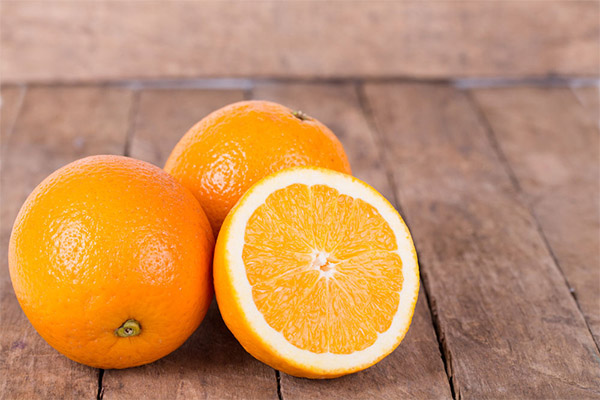
- Citrus was known and cultivated in ancient Egypt.
- In a tropical climate, a ripe fruit has a green color, it becomes orange with a lack of sun.
- Freshly squeezed juice is effective for heartburn.
- Daily use of fruit pulp allows you to extend youth and significantly inhibit age-related changes.
- According to research, orange flavor is considered the third most popular after chocolate and vanilla.
Orange jam improves mood and increases the body's internal reserves. And no matter what the recipe it was cooked, a treat will remain for many the most beloved.
«Important: all information on the site is provided exclusively in fact-finding purposes. Before applying any recommendations, consult with a profile specialist. Neither the editors nor the authors are liable for any possible harm caused materials. "

